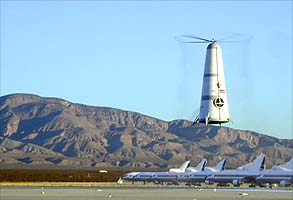| . |  |
. |
 Mojave - October 18, 1999 - Rotary�s Roton ATV (Atmospheric Test Vehicle) approach and landing demonstrator made its first translational (forward) flight in the envelope expansion flight program, flying 4,300 feet along a Mojave airport runway, at 07:23 am PDT, Tuesday October 12, 1999.
Mojave - October 18, 1999 - Rotary�s Roton ATV (Atmospheric Test Vehicle) approach and landing demonstrator made its first translational (forward) flight in the envelope expansion flight program, flying 4,300 feet along a Mojave airport runway, at 07:23 am PDT, Tuesday October 12, 1999.The ATV had previously been rolled-out for flight on October 6, 1999, but that flight had been cancelled due to poor weather conditions. This time the weather at Mojave Airport was perfect with a clear blue sky and no wind. The 65 feet tall by 22 feet diameter conical vehicle was piloted by a two person crew comprising the pilot, Dr. Marti Sarigul-Klijn, Cmdr. USN-Ret and Roton Chief Engineer, with Brian Binnie, Cmdr. USN-Ret. and Roton Flight Test Director, as copilot. Both crew members are highly qualified and experienced flight test pilots. The flight, the second in the envelope expansion flight test program for the Roton ATV and the third flight overall, was a low altitude translational (forward) flight south to north along Runway 30-12 at Mojave. This flight was to demonstrate the ability of the Roton ATV to fly at varying speeds under full control in a forward direction--exactly the same mode of flying that would be needed by a returning space vehicle maneuvering to land at an airport. In technical terms, the test was to investigate the longitudinal stability and control characteristics of the Roton ATV in forward flight. During the test, the ATV reached a maximum altitude of 75 feet above the Mojave runway and a maximum ground speed of approximately 53 miles per hour and flew a total of 4,300 feet along the runway. All values were within parameters planned for the flight. Observers along the flight path noted that "The ATV thundered past them like an express train--a truly awesome experience!" All flight test requirements were exceeded and exceptionally good flight data was obtained. Preliminary analysis of the flight data obtained shows good correlation with the ATV�s integral hardware-in-the-loop simulator and the flight data will be used to further fine-tune the simulator. After the translation portion of the flight, the pilots used their remaining fuel allowance to maintain a sustained, controlled, hover before touching down gently, once again demonstrating the ATV�s ability to execute precision, soft, landings. The total test duration from rotor start to rotor stop was 9 minutes 45 seconds. The total flight time was 3 minutes 47 seconds, of which 1 minute 50 seconds was in forward flight and 1 minute 57 seconds was spent in hover at the end of the flight. The total accumulated flight time on the ATV is now 6 minutes and 27 seconds During the debriefing, the pilots commented that a key factor in the success of the flight was their ability to plan and rehearse the flight on the ATV�s integral hardware-in-the-loop simulator prior to flight. They said that while the ATV was not at all hard to fly, it was significantly different to any existing rotorcraft or aircraft, so practice was required beforehand in order to fly the test profile smoothly. The primary function of the Roton ATV is to demonstrate the operational viability of vertically landing a returning space vehicle using a tip thruster powered rotor-blade landing system. The ATV flight test program will verify the Roton�s pilot-guided approach and landing capability over a range of flight regimes. Gary C. Hudson, President and CEO of Rotary Rocket Company said after the successful conclusion of the flight, "An extremely successful and impressive test. There is now no doubt in our minds, or in the minds of those present at the test, that the Roton does fly and, in fact, it flies very well." Hudson added that "The quality of the flight data obtained from this flight is such that it may well be possible to reduce the scale of the ATV flight test program without compromising results. This is an important consideration for a small company such as ours operating within our budget constraints."
|
| |||||||||
| The content herein, unless otherwise known to be public domain, are Copyright 1995-2016 - Space Media Network. All websites are published in Australia and are solely subject to Australian law and governed by Fair Use principals for news reporting and research purposes. AFP, UPI and IANS news wire stories are copyright Agence France-Presse, United Press International and Indo-Asia News Service. ESA news reports are copyright European Space Agency. All NASA sourced material is public domain. Additional copyrights may apply in whole or part to other bona fide parties. Advertising does not imply endorsement, agreement or approval of any opinions, statements or information provided by Space Media Network on any Web page published or hosted by Space Media Network. Privacy Statement All images and articles appearing on Space Media Network have been edited or digitally altered in some way. Any requests to remove copyright material will be acted upon in a timely and appropriate manner. Any attempt to extort money from Space Media Network will be ignored and reported to Australian Law Enforcement Agencies as a potential case of financial fraud involving the use of a telephonic carriage device or postal service. |